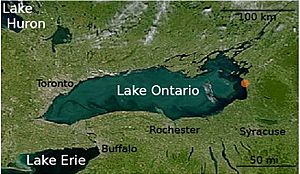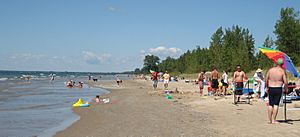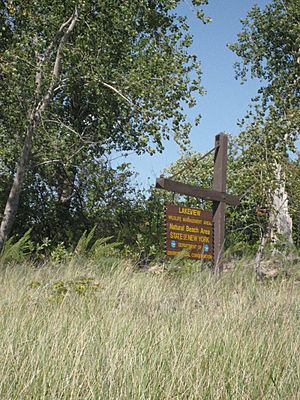Southwick Beach State Park facts for kids
Southwick Beach State Park is a fun New York State park located on the eastern shore of Lake Ontario. This park has a special sandy beach. It covers about 464 acres and has a beach that is 3,500 feet long! Around 100,000 people visit the park every year.
Right next to the park, to the south, is the Lakeview Wildlife Management Area. This area is much bigger, about 3,461 acres. It adds several more miles of public beach for everyone to enjoy. Both the park and the wildlife area are in the Town of Ellisburg in Jefferson County, New York.
The park is a great place to visit! It has a large campground where you can set up tents or park trailers. There are also picnic areas, sports fields, and a playground. In the summer, lifeguards watch over the swimming area, and a park store is open. When winter comes, you can even ride snowmobiles in the park.
Southwick Beach State Park has a nature trail that is easy to use for everyone. You can also find hiking trails that go from the park into the Lakeview Wildlife Management Area. The Lakeview area has places to launch boats and another nature trail along South Sandy Creek. You can find maps and information about these trails and boat routes online and in guidebooks.
This park and wildlife area are part of a rare freshwater coastal environment. This means they have beaches, sand dunes, bays, and marshes. The Lakeview Wildlife Management Area is even a special place called the Lakeview Marsh and Barrier Beach National Natural Landmark. It was named in 1973 as one of the best marshlands along eastern Lake Ontario. Both Southwick Beach State Park and Lakeview Wildlife Management Area are part of the "Eastern Lake Ontario Barrier Beach and Wetland Complex." Lakeview is also part of the Eastern Lake Ontario Marshes Bird Conservation Area, which helps protect birds.
Contents
Amazing Dune Plants
The sand dunes right next to the beach are home to special plants, mostly beachgrass. This beachgrass is amazing because it helps build the dunes! It grows long roots under the sand that connect like a strong rope. These roots trap sand, which helps the dune grow bigger.
You might also see other plants like tall wormwood, cottonwood trees, and sand dune willows growing among the beachgrass. Cottonwood is the only tree in this area that helps form dunes. Sand dune willows are quite rare in New York State, but they are common here. This "beachgrass plant community" is very important because it keeps the dunes from being blown away by wind and storms. It also allows other, more complex plants like poison ivy and dune grape to grow deeper in the dunes.
Protecting Our Dunes
When too many people or animals walk on the beachgrass, it can get damaged. In some busy parts of the eastern Lake Ontario dunes, foot traffic has completely destroyed this plant community. Without the beachgrass, the sand dunes can be easily blown away by the wind.
To help fix this, people started working in the early 1990s to restore the beachgrass along eastern Lake Ontario. They built wooden "walkovers" to help people cross the dunes without stepping on the plants. These walkovers lead from the beach to trails and waterways inside the park. Along with the restoration, there have been programs to teach people about how important it is to protect the dunes. A special "photomonitoring project" from 1995 to 2005 showed how much the beachgrass has improved.
There are different types of beachgrass. Long ago, the beachgrass here was known as "Champlain beachgrass." It's only found along eastern Lake Ontario and Lake Champlain. It looks a lot like the common American beachgrass found on the Atlantic coast, but it blooms in July instead of September. Later, a type called "Cape variety" American beachgrass was brought to the area, and now it grows mixed with the Champlain type.
Fun Times and History at Southwick Beach
Southwick Beach State Park is named after the Southwick family. They owned the land for almost 100 years, from 1870 to 1960. Some maps even call it "Southwick's Beach State Park."
Starting in the 1920s, some people tried to build fun places on the property. The most famous was Albert Ellis. He rented the beach from the Southwick family for about 15 years. He turned it into a place like Coney Island for Northern New York! The beach had a roller coaster, bathhouses, a dance hall, a merry-go-round, and a midway with games. Albert Ellis also started the Jefferson County Amateur Baseball League. A baseball field was built at Southwick Beach, and for several years, there was even a Southwick Beach baseball team! Sadly, these businesses closed during the Great Depression (from 1929 to 1941).
By the 1950s, people realized how important the eastern Lake Ontario shoreline was for fun and for protecting nature. But most of this land was not owned by the public. In 1960, a company bought the beach from the Southwick family and ran it as a fun spot for five years. Then, in 1965, the New York State Office of Parks, Recreation and Historic Preservation bought the property for $150,000. Southwick Beach State Park officially opened in May 1966.
How Southwick Beach Was Formed
The sandy beaches at Southwick Beach State Park are part of a 17-mile long sandy shore. This stretch goes from Sandy Pond in the south to Black Pond in the north. Another similar sandy beach on Lake Ontario is at Sandbanks Provincial Park in Prince Edward County, Ontario, Canada. These are the main sandy beach areas on Lake Ontario.
Experts say the eastern Lake Ontario dunes are like the south shore of Long Island. They have "drowned river mouths" that form lagoons behind long, curving sandbars. These lagoons are the ponds you see in the area, like Black, Lakeview, North Sandy, and South Sandy ponds.
The rivers and their mouths are not easily seen today. About 10,000 years ago, after the last ice age, the water level of Lake Ontario was much lower than it is now. Imagine big rivers flowing into a lake that was many feet lower! As the water level of Lake Ontario rose, these river mouths became "drowned." Also, the sand we see on the beaches today was probably formed a long time ago. It was carried down from higher places when the lake's water levels were low after the ice age.
- New York State Department of Environmental Conservation (2005). "Map of Southwick Beach State Park and Lakeview Wildlife Management Area", archived at WebCite from this original URL 2008-04-22.





